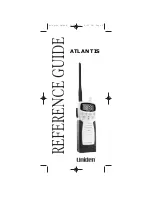
WARNING
Do not perform the linking procedure while the
motor's main wire connected or the engine is
operating as it may result in serious injury.
When the linking is complete, please cycle
the receiver power and ensure the receiver is
properly linked to the transmitter.
Please power up your system in this order.
Transmitter first, followed by the receiver.
If the R7008SB receiver was previously linked to
another transmitter, make sure that transmitter
is not operating while linking the receiver to the new
transmitter.
FUTABA CORPORATION
1080 Yabutsuka, Chosei-mura, Chosei-gun, Chiba-ken, 299-4395, Japan
Phone: +81 475 32 6982, Facsimile: +81 475 32 6983
Link to the transmitter
Easy Link ID allows FASSTest receivers to link
to compatible transmitter without pressing the
link button on the receiver.
1
Bring the transmitter and the receiver
close to each other, within 20 inches (half
meter).
2
Tu r n o n t h e t ra n s m i t t e r. P l a c e t h e
transmitter into the receiver linking mode.
3
Turn on the receiver.
4
The receiver will wait for the linking
process to begin for 2 seconds. Following
that it will return to the normal operation
mode.
5
When the LED of the receiver changes
from blinking red to solid green, linking is
complete.
(A link waiting state is ended in 1 second.)
• Refer to the transmitters operation manual for complete details on how to place the transmitter into the linking mode.
• If there are many FASSTest systems turned on in close proximity, your receiver might have difficulty establishing a link to
your transmitter. This is a rare occurrence. However, should another FASSTest transmitter/receiver be linking at the same
time, your receiver could link to the wrong transmitter. This is very dangerous if you do not notice this situation. In order
to avoid the problem,we strongly recommend you to double check whether your receiver is really under control by your
transmitter.
• If the System Type of the transmitter is changed, the receiver will need to be re-linked to the transmitter.
Channel Modes
The R7008SB is capable of changing its channel allocations as described in the table below. This is
especially important when using the receiver in a dual receiver mode. See your transmitter operation
manual for complete details on operating in the dual receiver mode.
1
Press and hold down the Link/Mode
button on the R7008SB receiver.
2
Turn the receiver on while holding down
the Link/Mode button. After power up, the
button can be released.
3
The LED should now be blinking red in
one of the patterns described by the chart
below.
4
Each press of the Mode/Link button
advances the receiver to the next mode.
5
When you reach the mode that you wish
to operate in, press and hold the Mode/
Link button for more than 2 seconds.
6
Once locked into the correct mode the
LED will change to a solid color.
7
Please cycle the receiver(s) power off and
back on again after changing the Channel
Mode.
FASSTest
FASSTest
is a bidirectional communication system
between the R7008SB receiver and FASSTest capable
transmitters. Multiple optional telemetry sensors may
be connected to the
S.BUS2
on the receiver and that
data is in turn displayed on the transmitter.
*Please see your transmitters operation manual
to configure transmitter to operate with telemetry
sensors.
S.BUS2
S.BUS2
extends
S.BUS
and supports bidirectional
communication. Sensors are connected to the
S.BUS2
port.
*Only S.BUS2 capable devices may be connected
to the S.BUS2 port. Standard S.BUS servos and
gyros should not be connected to the S.BUS2
port.
Output
connector
Channel
Mode A
1 〜 8CH
Mode B
1 〜 7CH
Mode C
9 〜 16CH
Mode D
9 〜 15CH
1
1
1
9
9
2
2
2
10
10
3
3
3
11
11
4
4
4
12
12
5
5
5
13
13
6
6
6
14
14
7/B
7
7
15
15
8/SB
8
S.BUS
16
S.BUS
Red LED
blink
1 time
2 time
3 time
4 time
R7008SB CH Mode table
WARNING
Turn on the power in transmitter
→
receiver order. In addition, always check the operation
of all the servos before flight.
Do not insert or remove the servo connector while the receiver power is ON.
Since the S.BUS servo switches the operation mode automatically according to the type of signal
(S.BUS signal/PWM signal) from the receiver, if the connector is inserted or removed while the power is
ON, an S.BUS connected servo will be erroneously recognized and may stop.
©FUTABA CORPORATION 2016, 10 (1)
S.BUS hub
S.BUS hub
S.BUS output
S.BUS
Ch output/
Battery terminal
R2008SB
Battery
S.BUS servo
Conventional
servo
2ch
4ch
3ch
5ch
6ch
What is S.BUS?
* Set the channel of
S.BUS
servos by using an
SBC-1
channel changer,
CIU-2
USB serial inter-
face or the programming software resident in the
18MZ
transmitter.
*
Can also be used together with conventional
servos. However, conventional servos cannot be
used by the
S.BUS
output.
*
When using servos with a remote battery pack,
use
S.BUS
Hub with Cable (2-way/remote bat-
tery pack use).
Please refer to the instruction manual of
S.BUS
Hub with Cable (2-way/remote battery pack use)
for the connection method.
[Connection by S.BUS system]
Unlike conventional radio control systems, the
S.BUS
system uses data communication to transmit
control signals from a receiver to a servo, gyro, or
other
S.BUS
compatible device. This data includes
commands such as “move the channel 3 servo to 15
degrees, move the channel 5 servo to 30 degrees”
to multiple devices. The
S.BUS
devices execute
only those commands for their own set channel. For
this reason, it can be used by connecting multiple
servos to the same signal line.




















